By Margaret Goddard
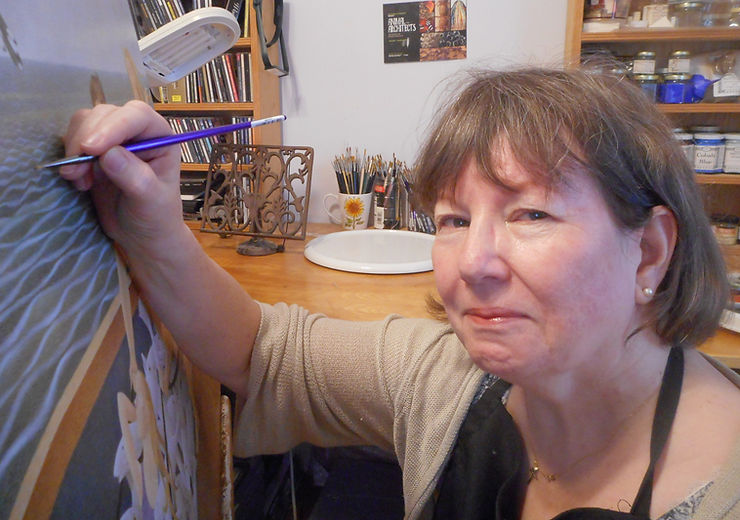
The Studio Spotlight series started in 2019, featuring studio visits around Monmouth County with artists of all mediums. During the quarantine period caused by COVID-19 in 2020, we're continuing to visit artists' studios remotely to check in on how local artists are coping and creating amidst hardship.
Eileen Kennedy is an artist who is not afraid to work for months or years at a time on a single painting. In fact, it suits her. She works in egg tempera, a Renaissance medium where the artist mixes pigment with egg yolk and applies the paint with a fine brush, layering tiny opaque and translucent strokes to create a hazy blend of color. Eileen has been working on her current painting Bycatch (pictured below), for six months already, and she still has at least another month to go.
Eileen describes herself as a storyteller. But although Eileen’s paintings deal with narrative, she describes her paintings as “more like poems than novels.” They depict situations without explaining exactly what is going on. “I don’t want to rain on someone’s parade with a big long narrative.” She likes to evoke enough emotion that “someone can make up their own stories.”
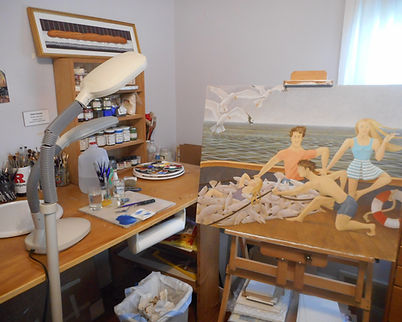
In her paintings, you’ll often find people interacting with and immersed in nature. She has been interested in the human impact on ecosystems since she served as Deputy Director of the American Littoral Society on Sandy Hook for a time. She started Bycatch, for example, with an interest in the occupation of fishing, and “people who earn a living from taking what’s already there.” She was also thinking about the biblical implications of teaching people to be “fishers of men.”
In this Studio Spotlight, we discuss Bycatch and another project she is working on, Zoom Dream, a woodcut print that speaks to how physical distancing during quarantine makes us feel emotionally disconnected from other humans.
1. Why do you make art?
For me, making art is a compulsion. Since I first started while still in my teens, I have never not made art or lacked inspiration. At first I was just compelled to “capture” the world in drawings. Then I began to create more and more detailed compositions. Now, after more than 50 years, the medium has changed but the quest to compose is still there. I think I’m getting closer.
2. How does your medium influence the art you make?
Egg tempera and silverpoint are my primary media. Both are labor intensive, making the process meditative. They support my linear style and permit me to realize a high level of detail. I gravitated toward these media because I love telling stories and drawing and these let me fully embrace both.
This is my egg tempera painting setup (pictured below). The shelves in the background hold jars and bags of raw pigment. My mixing palette is a slab of marble. To the right, porcelain palettes of pigment moistened with a little water to keep the dust down sit on a turntable for easy access while painting. You can see a lot of brushes—I go through a lot of brushes. These are pointed watercolor brushes. The gesso panels wear them down quickly.
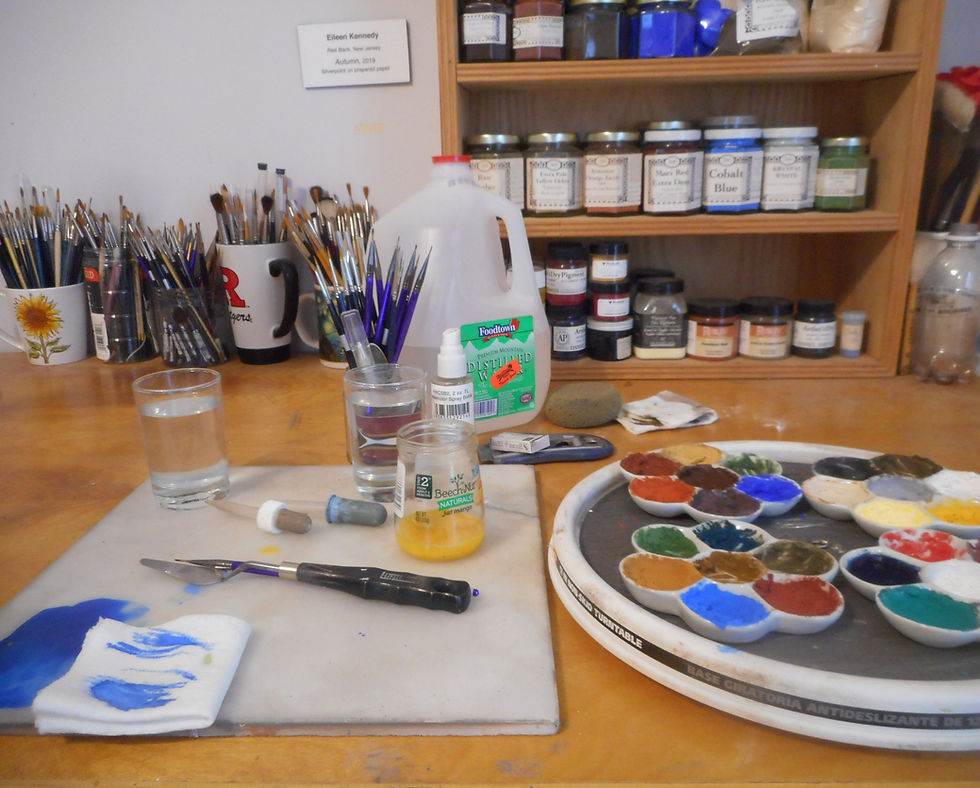

3. Where do you find or look for inspiration?
Most ideas just pop into my head—or perhaps I should say, they are revealed. But that is just the beginning. Once I have the germ of an idea, I have to populate the composition with the right figures, flora, fauna and “stuff.” I love to include familiar flowers, leaves, birds and critters that have been the natural backdrop of life here in coastal Monmouth County. Once in a while I’m inspired by another art form, such as a musical piece or a poem.
When Eileen is in the composing stage of a painting, she sketches a ton to figure out exactly what the composition will look like. Egg tempera is unforgiving because each stroke dries almost immediately, and to “erase,” one has to use a razor blade to scrape back to the base layer. So you have to know exactly what your plan is before you start. “It’s fun to me; it’s like doing a puzzle,” Eileen says.
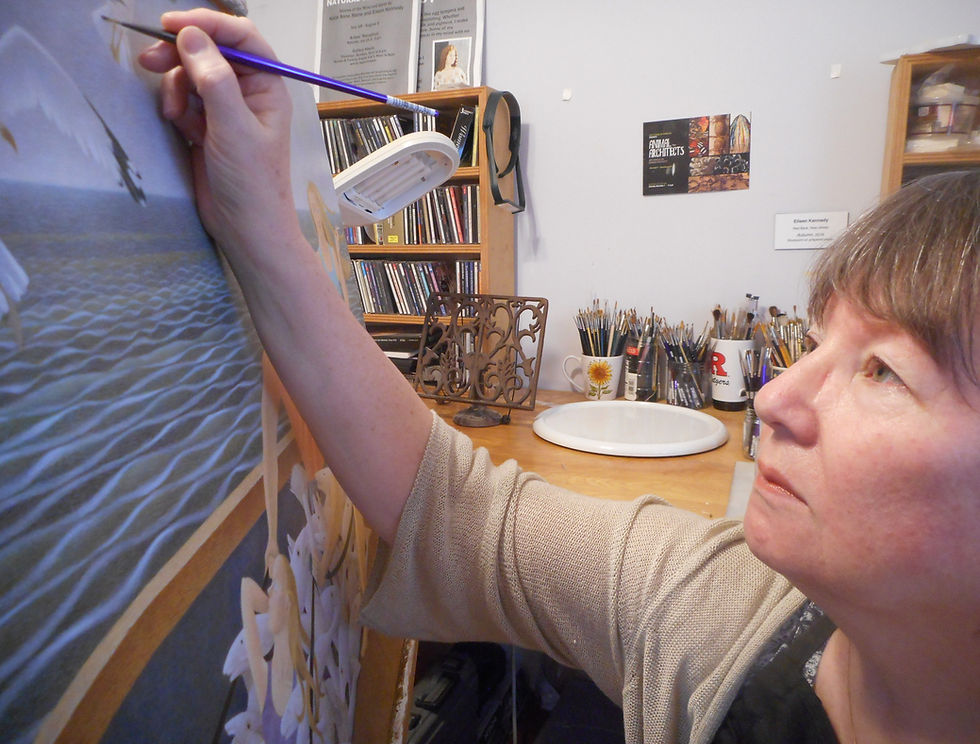
4. Do you work in silence or with music or the radio on?
Sometimes I listen to music—everything from Medieval chant to Janis Joplin. Most of the time I listen to audio books. Sorry, but nothing erudite—I confess I am addicted to murder mysteries. Right now I’m listening to Patricia Cornell’s Kay Scarpetta series and Louise Penny’s novels. I spend 25 to 30 hours per week in the studio so I listen to three or four novels per week. Since the pandemic, I’ve also been enjoying some great live concerts from artists’ homes.
5. Do you have an object or reference that you keep around to inspire you?
Not really—I’m really not too aware of my surroundings when I’m working.
6. What is your quirkiest studio habit?
I know this makes me sound like a really boring art nerd, but when I make gesso panels, it’s a five-day process, so I make a little booklet with all the steps for each day listed with check boxes so I don’t lose track of what I’m doing.
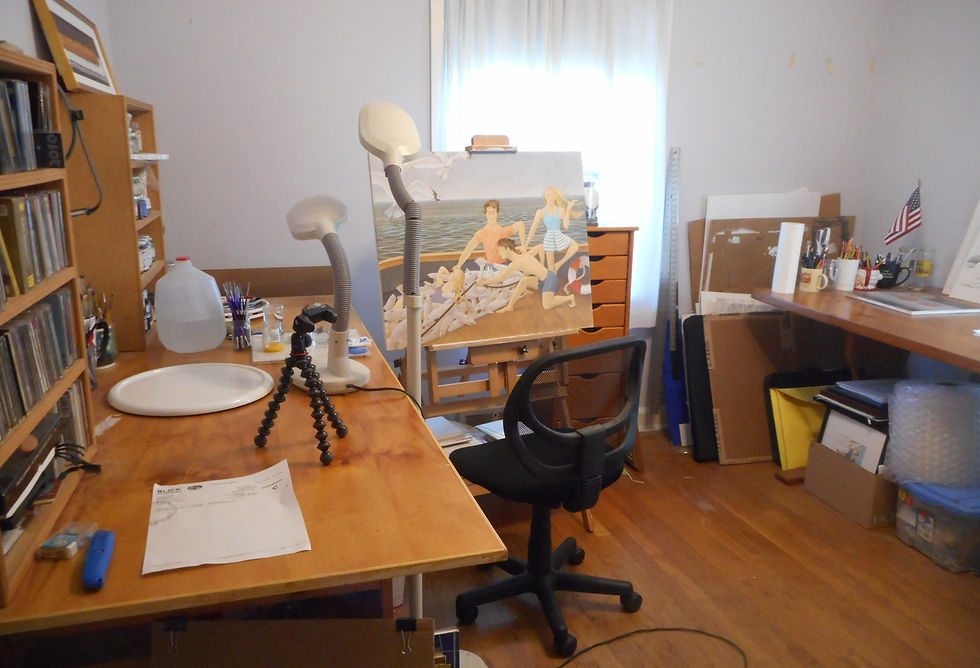
7. What three words would you use to describe this studio?
Mine
Cozy
Home
8. Has your art changed during this time of physical distancing?
I think the fact that my work has not changed has kept me sane. My paintings take four to five months to complete. The one I’m working on now is quite large for egg tempera—24 x 30 inches—and I’ve been working on it for six months. The only difference is that I was inspired to create the woodblock print, Zoom Dream. I usually only create one woodcut per year as Christmas gifts for friends, family and colleagues. For a while I’ve been wanting to get back into woodblock printing, which I did in college. I want to be able to get out smaller ideas more quickly [in comparison to the months-long egg tempera painting process] and sell multiple prints of a piece.
9. How did you come up with the idea for your recent piece, Zoom Dream?
I work a day job and also volunteer in a number of organizations, and we’ve all been spending a lot of time on the Zoom platform. Like most people, during meetings I think about how nice it will be to see folks face to face again. One day I was daydreaming during a meeting about how cool it would be if we could escape the bonds of the Zoom grid. I decided to make that happen. Woodcut is such a direct and fast process that I decided to use that medium. I didn’t want people to forget what this moment was like.
10. What do you hope the world looks like post-quarantine?
It will be great to be with people again—especially for those who haven’t been able to do their normal work. I’ll especially be glad to see the arts restored. At least we visual artists can continue to work in isolation. In fact, with few exceptions, we always work in isolation. But talking to some of my theater and musician friends—their lives and livelihoods have been taken from them. Zoom just doesn’t cut it for them.

11. Who’s on your radar right now? (artists, idols, collaborators etc.)
I discovered the work of American painter George Tooker in 1976. Since then, his work is never far from mind. His amazing egg tempera work inspired me to pursue the medium of egg tempera. I never thought it would take me 40 years to figure it out.
12. What’s a piece you’ve made that you’ll never get rid of or sell?
My first egg tempera painting is a little portrait of my father in his Navy uniform. I painted it in a workshop about two months after he died and gave it to my mother. When she died, it came back to me. It sits on my mantle and it’s going to stay there.
Creating Zoom Dream, pictured below
I usually have multiple projects on the drawing board at a time. Right now there are sketches for the tempera painting Bycatch and for the woodcut Zoom Dream.
Woodcut block is cut and ready for printing. To the right are my woodcut tools, sharpening stone, and ink. Recently I switched from oil-based printing ink to soy-based inks that clean up with soap and water—healthier, easier to clean up, and better for the environment. This table is along the wall opposite my painting table. I use it for panel making, woodcut work, framing, and other projects.
This close up of the cut block shows the cut marks in the Baltic birch panel. I usually like to work in solid poplar or cherry but this is a larger print and hardwood boards are not available in widths wider than 12 inches.
Rolling ink on the block with a hard rubber roller or “brayer."
I apply Unryu paper from Japan onto the inked block using a register frame to ensure even margins and smooth it with the palm of my hand and then rub the entire block with the back of a wooden spoon to transfer the ink to the paper.
The prints are hung to dry overnight.
















Comentarios